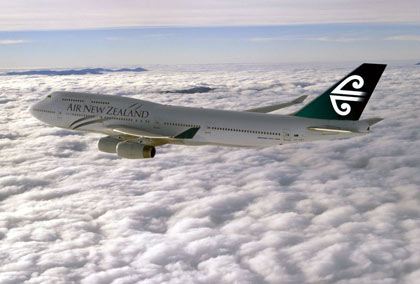You are hereBlogs / WcP.System.Thinker's blog / World first fuel-saving carbon-cutting program: Air New Zealand passengers take a ride on the 'perfect flight'
World first fuel-saving carbon-cutting program: Air New Zealand passengers take a ride on the 'perfect flight'

(quote)
Air New Zealand's "perfect flight" using optimal flying conditions and the co-operation of US, New Zealand and Australian aviation authorities, was hailed as a success in San Francisco on Friday. Using new technologies and procedures on a flight from Auckland, Air New Zealand cut waiting time, trimmed flying time, saved 1,200 gallons of fuel (around 4% less fuel than normally used), eliminated 30,000 pounds of harmful carbon emissions and took a quieter approach on arrival at San Francisco International Airport.

The normal commercial flight NZ8, dubbed ASPIRE 1 (Asia and South Pacific Initiative to Reduce Emissions) is the first tailored test flight on the Pacific using technology and cleared gates at each end, eliminating air traffic congestion to test flight and fuel efficiency. It is part of a worldwide drive to make the aviation industry more environmentally friendly.
The aircraft sourced power from Auckland Airport's supply while still on the tarmac instead of burning its own fuel to drive electricity while boarding passengers. Six hourly updated weather reports sent electronically using GPS-based navigation to on-board computers meant the pilots could change their flight path to avoid bad weather. They therefore didn't need to rely on air traffic controllers. The flight made three deviations during the night. Two made small savings but one change, south-east of Hawaii saved 350kg of fuel and two minutes flying time.

Maximum thrust was used on take off to reach optimum altitude as soon as possible and an uninhibited gradual, slow descent on landing instead of the usual rev up and rev down procedure, all contributed to the fuel savings. The landing was also quieter. The Federal Aviation Administration hopes to implement the landing procedure at Los Angeles International Airport next year. The FAA said the continuous descent approach could reduce noise by 30% at LAX, helping to address complaints from people living near the airport.
Airlines contribute 2-3 per cent of the world's CO2 emissions and aviation authorities and airlines are working around the world to reduce the footprint with technological advances and new flying patterns. The flight could mark the first major step in altering the way airlines operate their planes, FAA and Air New Zealand representatives said. "Today is just a great day for aviation," said Robert Sturgell, the FAA's acting administrator, who was on hand to greet the arrival of the regularly scheduled flight. "Clearly we're headed in the right direction."

For the FAA, Friday's flight was a boost for its multibillion-dollar effort to modernize air-traffic control. It has been stalled in Congress, where lawmakers have questioned the ambitious plan that includes setting up an advanced satellite-based air-traffic-control system. In an interview Friday, the FAA's Sturgell said the flight helped show that parts of the modernization effort were already in place. For instance, the flight used satellite-based communications to get up-to-date weather reports that were used to divert the flight to a more fuel-efficient path.
"All in all it was a very successful flight," David Morgan, the airline's general manager for operations and safety who spearheaded the initiative, said shortly after the plane landed about 10 minutes ahead of schedule. "It exceeded our expectations." United Airlines and Qantas will follow Air New Zealand with gate-to-gate test flights across the Pacific. US airlines have done full and partial tailored flights in the US and similar flights are being done by other airlines across the Atlantic into Miami. Plans are also underway to do them out of Europe in the hope that all aircraft will do them one day.
(unquote)
Photos courtesy of Paul Sakuma / Associated Press, Air New Zealand, LA Times, AFP
Original Source: LA Times and Stuff.co.nz


















